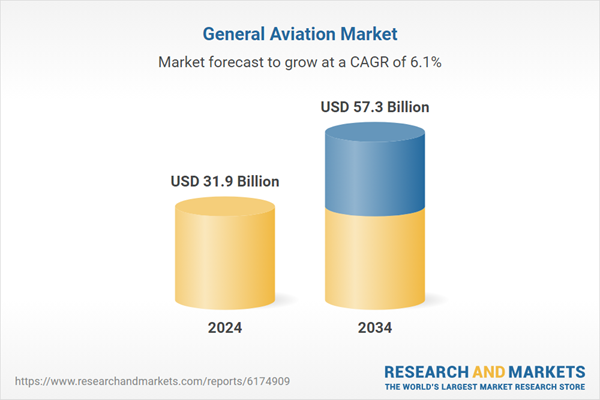Several key factors are fueling this growth, including rising demand for private and recreational aviation, improvements in safety and avionics technologies, a surge in flight training programs, and greater investments in aviation infrastructure. Increased interest in personal flying experiences and corporate travel convenience is expanding the market footprint. Additionally, the adoption of smart aviation systems using AI, IoT, and autonomous technologies is changing the landscape by making aviation operations more efficient, safe, and predictive. These advanced systems are enabling smarter design, better diagnostics, and improved maintenance routines. Infrastructure upgrades are also playing a major role, ensuring that private and business aircraft have better access and operational ease. The convergence of evolving technology with consumer expectations is reshaping how general aviation services are delivered and sustained globally.
In 2024, the fixed-wing aircraft segment generated USD 26.7 billion, attributed to the versatility, fuel efficiency, and expanding fleet of fixed-wing models across private, business, and training applications. Companies are placing strategic emphasis on developing sustainable and multi-functional aircraft that meet modern demands, including the integration of hybrid and electric propulsion systems. By innovating for performance, reliability, and environmental sustainability, businesses are aiming to make fixed-wing aviation more adaptable to future needs.
The business jet segment was valued at USD 22.8 billion in 2024. Increased corporate expenditure, growing demand for flexible and time-efficient travel, and health-conscious travelers opting for private flights are key contributors to this segment’s success. Manufacturers are channeling efforts into creating jets that offer enhanced safety features, improved speed, operational cost-efficiency, and greater in-flight flexibility. Emphasis is being placed on aircraft designs that fulfill modern expectations of corporate travel, balancing luxury and function with cost and time savings.
United States General Aviation Market was valued at USD 14.8 billion in 2024, driven by a rise in pilot training programs, shifts in regulatory frameworks, and innovations aimed at boosting fuel efficiency and operational performance. Companies in the U.S. are focusing on producing technologically advanced, fuel-conscious aircraft and avionics systems. Alongside, there is a clear push to upgrade training standards and align product development with the evolving aviation policies and operational standards in the country.
Prominent players contributing to the General Aviation Market include MD Helicopters, Nextant Aerospace, Pilatus Aircraft Ltd., Textron Aviation, Bombardier Inc., Mooney International Corporation, Airbus, Piper Aircraft, Inc., Cirrus Design Corporation, Epic Aircraft, LLC., Boeing, Leonardo S.p.A., Honda Aircraft Company, Piaggio Aerospace S.p.A., Embraer, Robinson Helicopter Company, Gulfstream Aerospace, Enstrom Helicopter Corporation, Diamond Aircraft Industries, and Dassault Aviation SA. Key strategies adopted by leading companies in the general aviation market include a strong focus on R&D to produce technologically advanced, energy-efficient aircraft that meet evolving environmental standards and customer preferences. Firms are leveraging innovation in hybrid-electric propulsion systems and next-gen avionics to stay competitive.
Comprehensive Market Analysis and Forecast
- Industry trends, key growth drivers, challenges, future opportunities, and regulatory landscape
- Competitive landscape with Porter’s Five Forces and PESTEL analysis
- Market size, segmentation, and regional forecasts
- In-depth company profiles, business strategies, financial insights, and SWOT analysis
This product will be delivered within 2-4 business days.
Table of Contents
Companies Mentioned
The key companies profiled in this General Aviation market report include:- Airbus
- Boeing
- Bombardier Inc.
- Dassault Aviation SA
- Embraer
- North America
- Cirrus Design Corporation
- Epic Aircraft,LLC.
- Gulfstream Aerospace
- Mooney International Corporation
- Piper Aircraft,Inc.
- Robinson Helicopter Company
- Textron Aviation
- Nextant Aerospace
- Asia Pacific
- Honda Aircraft Company
- Europe
- Diamond Aircraft Industries
- Leonardo S.p.A.
- Piaggio Aerospace S.p.A.
- Pilatus Aircraft Ltd.
- Enstrom Helicopter Corporation
- MD Helicopters
Table Information
| Report Attribute | Details |
|---|---|
| No. of Pages | 190 |
| Published | September 2025 |
| Forecast Period | 2024 - 2034 |
| Estimated Market Value ( USD | $ 31.9 Billion |
| Forecasted Market Value ( USD | $ 57.3 Billion |
| Compound Annual Growth Rate | 6.1% |
| Regions Covered | Global |
| No. of Companies Mentioned | 24 |









